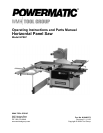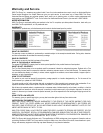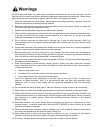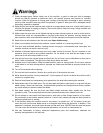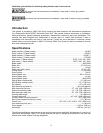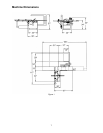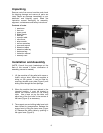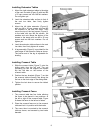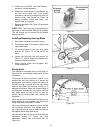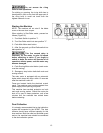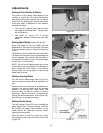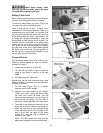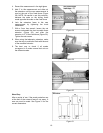
4
Warning
As with all machines, there is a certain amount of hazard involved with the use of this panel saw. Use the
machine with the respect and caution demanded where safety precautions are concerned. When normal
safety precautions are overlooked or ignored, personal injury to the operator can result.
1. Read and understand the entire owner’s manual before attempting assembly or operation. Know the
limitations and hazards associated with this machine.
2. Read and understand the warnings posted on the machine and in this manual. Failure to comply with
all of these warnings may cause serious injury.
3. Replace the warning labels if they become obscured or removed.
4. This panel saw is designed and intended for use by properly trained and experienced personnel only.
If you are not familiar with the proper and safe operation of a panel saw, do not use until proper
training and knowledge have been obtained.
5. Do not use this panel saw for other than its intended use. If used for other purposes, WMH Tool
Group disclaims any real or implied warranty and holds itself harmless from any injury that may result
from that use.
6. Always wear approved safety glasses/face shields while using this panel saw. Everyday eyeglasses
only have impact resistant lenses; they are not safety glasses.
7. Before operating this panel saw, remove tie, rings, watches and other jewelry, and roll sleeves up
past the elbows. Remove all loose clothing and confine long hair. Protective type footwear should be
used. Anti-skid floor strips are recommended. Do not wear gloves.
8. Where the noise exceeds the level of exposure allowed in Section 1910.95 of the OSHA Regulations,
use hearing protective devices.
9. Some dust created by power sanding, sawing, grinding, drilling and other construction activities
contain chemicals known to cause cancer, birth defects or other reproductive harm. Some examples
of these chemicals are:
• Lead from lead based paint.
• Crystalline silica from bricks, cement and other masonry products.
• Arsenic and chromium from chemically treated lumber.
Your risk of exposure varies, depending on how often you do this type of work. To reduce your
exposure to these chemicals, work in a well-ventilated area and work with approved safety
equipment, such as face or dust masks that are specifically designed to filter out microscopic
particles.
10. Do not operate this machine while tired or under the influence of drugs, alcohol or any medication.
11. Make certain the switch is in the OFF position before connecting the machine to the power supply.
12. Make certain that the machine frame is electrically grounded and that a ground lead is included in the
incoming electrical service. In cases where a cord and plug are used, make certain that the grounding
plug connects to a suitable ground. Follow the grounding procedure indicated in the National
Electrical Code.
13. Disconnect machine from power source before performing any service or maintenance or when
changing blades. A machine under repair should be RED TAGGED to show it should not be used
until the maintenance is complete.
14. Remove adjusting keys, wrenches, scrap or cleaning rags. Form a habit of checking to see that all
such items are removed from the machine before turning it on.
15. Keep safety guards in place at all times when the machine is in use. If removed for maintenance
purposes, use extreme caution and replace the guards before operating the machine.
16. Provide for adequate space surrounding work area and non-glare, overhead lighting.



